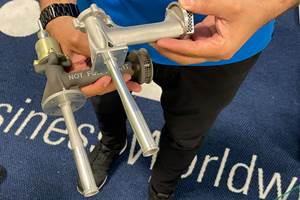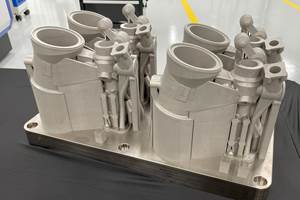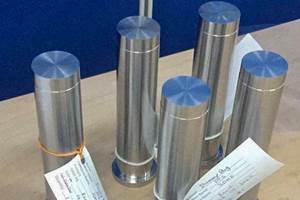Status Check: Repeatable and Distributed Manufacturing in AM — Ready Yet?
With potential drift and IP barriers, is metal additive manufacturing ready to contribute to distributed manufacturing?
Share
Read Next
Realizing the full promise of distributed manufacturing will involve national or worldwide production networks of localized, agile factories and “digital warehouses.” These networks will be able to provide shorter lead times, faster customer delivery, fewer assembly costs and, most importantly—near-and-on-demand inventory fulfillment.
Metal AM can uniquely contribute to this promise: It doesn’t require time-consuming tooling, it is open in the part geometries it can produce, scaling-up on additive technologies is relatively affordable, and metal AM easily integrates with CNC machining, heat treating and other existing mainstream postprocesses. So what is holding back the full adoption of metal AM into a distributed manufacturing framework? Part of the answer is dimensional and part of it relates to data.
What is Holding Us Back?
One of the key barriers to implementing distributed manufacturing through metal AM is the lack of repeatability across commodity AM processes. Repeatability is mandatory for same-location, same-system series production. And it’s most critical for production that takes place in small lots across the globe. Today, series production in metal AM is done in very limited, conservative circumstances, often followed by destructive and non-destructive testing. It’s not plug and play. Outcomes are nowhere near as predictable as CNC machining. This keeps AM out of mainstream production, for now.

With repeatable metal AM, different manufacturers can produce parts on compatible printers across multiple locations that are identical in dimensions and performance. This creates agile, distributed supply chains. Photo Credit: Velo3D
To get more technical, we need to consider how “drift” plays a role in repeatable quality and thereby repeatable metal AM production. Because of less-than-optimal build-chamber environments—from chamber condition, laser alignments, and recoater methods—settings and conditions can drift. Drift allows same-machine parts, or parts produced in different locations, to wander from their original specifications.
Calibration is very important in controlling drift. Metal AM equipment providers do have calibration routines, but most are time-consuming, done too infrequently and employ too few reliable controls. This creates lack of repeatability. When sending a print file to a machine in these situations, one has to validate that the file will work in each individual machine—and with each machine’s particular drift over time. Changing the print file itself along the way may be one way to match a desired outcome. But where is the normative standard then? How would high-value parts be made in different locations and by different contract manufacturers (CMs) to tight performance margins? How does drift impact sensitive stress requirements, for instance?
IP and Shared Data
More complications occur for distributed manufacturing when OEMs own the design as well as their own proprietary build parameters. Using CMs to achieve greater target-volume production, or target-location production, raises the question for OEMs of who controls the IP. Sending parameters into the supply chain that are then accessible by the contract manufacturer means that the OEM gives up some amount of control over their IP, particularly if this is maintained as a trade secret.
What’s more, CMs and service bureaus often have their own proprietary recipes or artisanal parameters that they apply to builds and that are not shared with the OEM. This can make it very difficult for the OEM to scale a supply chain, and these modifications and adaptations make tracking and control of distributed manufacturing outcomes even more uncertain. Most CMs today are more commercial outsourcing arrangements than they are quality-control partnerships—and this goes back to the lack of end-to-end integration in traditional metal AM systems .
What is Needed?
What is needed is more automation and integration within the AM build environment itself—from build-file software to highly-measurable, layer-by-layer, in-situ process and quality controls that result in process predictability and validated part repeatability. This is the formula for advanced metal AM and for successful distributed manufacturing. The advanced machine system does not have locked-in parameters, per se; it has calibration test outcome parameters that guide the build, control variation, and ensure the same production outcome. This self-contained quality setup protects IP and is done as often as one likes: each layer or each run or each week, in any location around the globe.
Fixing the Supply Chain
Just as AM consolidates individual parts for greater product efficiency, it can consolidate the steps in manufacturing and help decrease the “length” of a supply chain. Grouping core production processes together around advanced metal AM—in distributed regional and worldwide manufacturing networks—reduces the number of suppliers, assembly and logistical “touch points” and the distances involved in delivering products. Products don’t have to wait on cargo ships or meander across countries when manufactured in this way.
This vision is on the verge of realization—provided it’s founded on the most advanced AM tools coupled with connections to the resources and networks that can bring it to fruition.
About the Author

Benny Buller
Benny Buller, founder & CEO of Velo3D, observed the additive manufacturing (AM) industry with fresh eyes and no prior manufacturing experience. In doing so, he observed a fundamental flaw limiting the speed of AM adoption: Engineers not only had to learn a new manufacturing process (AM), but they also had to learn a new design process (DfAM). He built Velo3D from the ground up, solving for this root challenge, enabling design to inform manufacturing not the other way around.
Related Content
3D Printed Golf Putter Shafts: AM Tailors Weight Distribution for an Optimized Putting Stroke
Snarr3D offers high-performance golf putters with aesthetic features made possible through 3D printing. In manipulating the weight distribution of the golf putter shaft, Snarr3D aims to enhance accuracy and performance to give golfers the equipment suited to their individual game.
Read MoreQualification Today, Better Aircraft Tomorrow — Eaton’s Additive Manufacturing Strategy
The case for additive has been made, Eaton says. Now, the company is taking on qualification costs so it can convert aircraft parts made through casting to AM. The investment today will speed qualification of the 3D printed parts of the future, allowing design engineers to fully explore additive’s freedoms.
Read MoreWhy AM Leads to Internal Production for Collins Aerospace (Includes Video)
A new Charlotte-area center will provide additive manufacturing expertise and production capacity for Collins business units based across the country, allowing the company to guard proprietary design and process details that are often part of AM.
Read MoreConocoPhillips Sees Oil and Gas Supply Chain Opportunity With Additive Manufacturing
Production of parts when needed and where needed can respond to the oil and gas sector’s multibillion-dollar challenge of holding parts in inventory. The supply chain benefit will justify additive even before the design freedoms are explored.
Read MoreRead Next
4 Ways the Education and Training Challenge Is Different for Additive Manufacturing
The advance of additive manufacturing means we need more professionals educated in AM technology.
Read MoreAt General Atomics, Do Unmanned Aerial Systems Reveal the Future of Aircraft Manufacturing?
The maker of the Predator and SkyGuardian remote aircraft can implement additive manufacturing more rapidly and widely than the makers of other types of planes. The role of 3D printing in current and future UAS components hints at how far AM can go to save cost and time in aircraft production and design.
Read MoreHybrid Additive Manufacturing Machine Tools Continue to Make Gains (Includes Video)
The hybrid machine tool is an idea that continues to advance. Two important developments of recent years expand the possibilities for this platform.
Read More







.png;maxWidth=300;quality=90)














